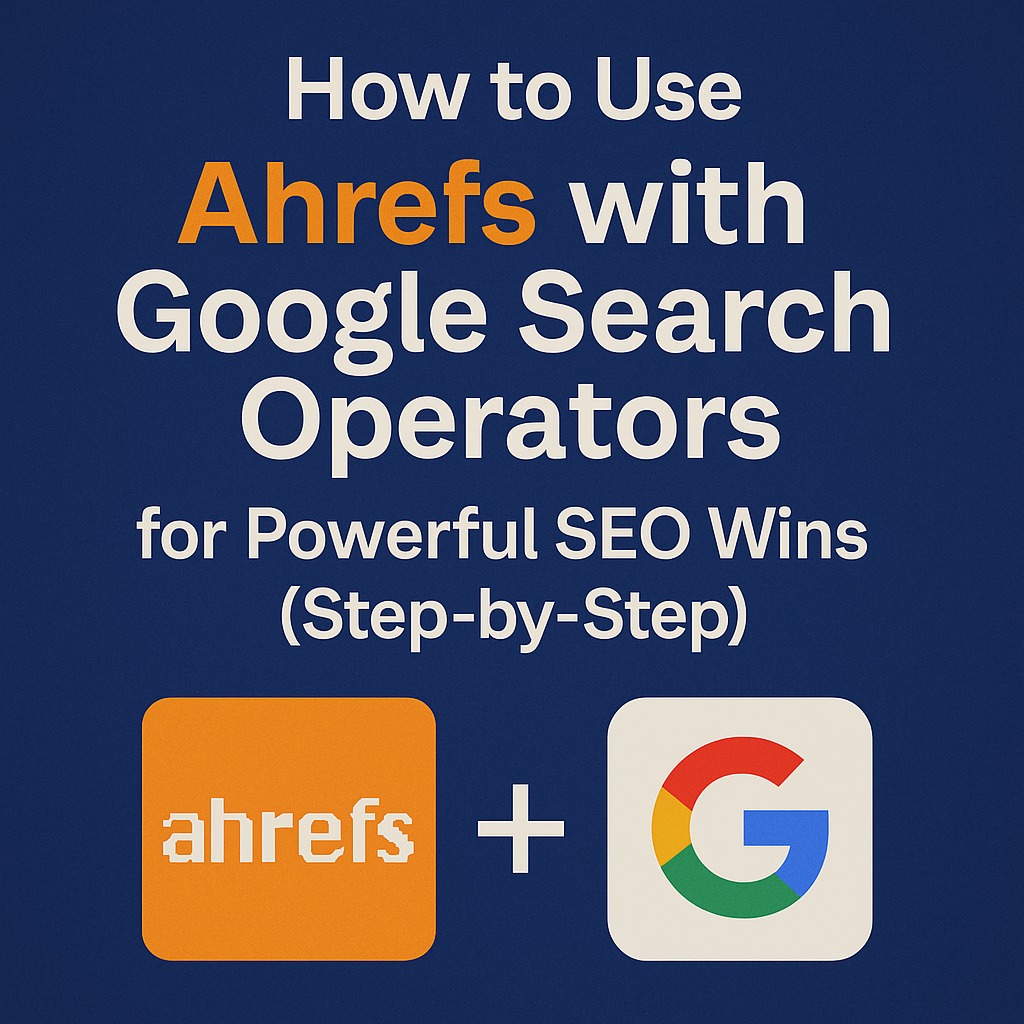Introduction: Unlocking a Hidden SEO Power Combo
Have you ever felt stuck trying to find new backlinks or content ideas—even with tools like Ahrefs?
Here’s a secret many SEO pros won’t tell you: combining Ahrefs with Google search operators opens up a whole new world of SEO opportunities. Whether you’re an aspiring blogger, digital creator, or marketing beginner, mastering this combo can give you an edge over your competition.
In this step-by-step guide, we’ll show you how to use Ahrefs Google search operators together to uncover guest posting sites, find high-traffic pages, and even spy on your competitors.
Let’s break it down in the simplest way possible.
What Are Google Search Operators? (And Why Should You Care?)
Google search operators are special commands that help you refine your Google searches. Instead of scrolling through endless irrelevant results, these commands let you get exactly what you want.
Commonly Used Search Operators:
| Operator | Function | Example |
|---|---|---|
site: |
Search only within a website | site:nytimes.com |
intitle: |
Search words in the title | intitle:"guest post" |
inurl: |
Look for keywords in the URL | inurl:"write-for-us" |
filetype: |
Find specific file formats | filetype:pdf SEO checklist |
" |
Exact match | "best SEO tools" |
OR |
Find either of two topics | Ahrefs OR SEMrush |
These commands help you target specific content—and when paired with Ahrefs, they become even more powerful.
What Is Ahrefs? A Quick Overview for Beginners
Ahrefs is one of the most trusted SEO tools used by marketers worldwide. It helps you:
-
Analyze competitor websites
-
Discover backlinks
-
Find keyword opportunities
-
Track ranking performance
-
Monitor site health
But here’s where most users go wrong—they only rely on Ahrefs’ interface.
What if you could bring Google’s deep crawl + Ahrefs’ data power together?
That’s what we’re diving into.
Why Combine Ahrefs with Google Search Operators?
If you’re wondering why you need to use both, here’s the deal:
Google search operators help you find SEO gold; Ahrefs helps you measure its value.
Imagine you find a blog post titled “Top AI Writing Tools” using Google. Now, run that same URL through Ahrefs Site Explorer—you’ll instantly see:
-
How many backlinks it has
-
What keywords it ranks for
-
How much organic traffic it gets
-
Its Domain Rating (DR)
That’s real SEO power.
Step-by-Step: Using Ahrefs + Google Search Operators for SEO Wins
Let’s walk through real-world examples that show how this combo works.
1. Find Guest Post Opportunities
Google Search:
This gives you a list of pages that accept guest posts related to AI tools.
Then in Ahrefs:
-
Copy each URL and paste it into Site Explorer
-
Check Domain Rating, Traffic, Backlinks
-
Filter out low-authority or spammy sites
-
Export your outreach list!
Pro Tip: Sort by traffic or DR to pitch only high-value sites.
2. Discover Competitor’s Most Linked Pages
Google Search:
You’ll see all blog URLs indexed by Google.
Ahrefs Magic:
-
Plug each URL into Ahrefs
-
Check Referring Domains
-
Analyze which pages are earning the most backlinks—and why
You’ll get clues on what content type gets the most attention in your niche.
3. Build a Niche Resource List
Google Search:
This shows pages that list marketing tools or articles.
Use Ahrefs:
-
Analyze each site’s authority
-
Find gaps in their resources
-
Pitch your content to be included
Strategy: Look for sites with low DR but high organic traffic—they’re often open to link swaps or collaboration.
4. Find Forum or UGC Content Ideas
Google Search:
Quora questions are goldmines for understanding real user problems.
What Ahrefs Adds:
-
Analyze those Quora URLs to see which ones rank on Google
-
Use Content Explorer to find similar posts with high shares
Then create better content than what’s ranking.
Real-Life Use Case: My Workflow as a Blogger
When I was trying to build links for a tech tutorial blog, I used this exact method:
-
Google Search:
-
Found ~30 sites
-
Plugged them into Ahrefs → filtered out low-traffic domains
-
Reached out to 12 websites
-
Got 4 backlinks with DR 40+ within 3 weeks!
That jumpstarted my domain’s authority and helped me rank for low-competition long-tail keywords.
Common Mistakes to Avoid
-
Overusing operators in a short time (can trigger Google block warnings)
-
Not validating with Ahrefs (some pages look good in Google, but have zero traffic)
-
Relying only on
intitleorinurl—combine 2-3 operators for best results -
Ignoring nofollow/dofollow tags in Ahrefs backlink analysis
Bonus Tips & Tools
| Tool | Purpose |
|---|---|
| Ahrefs Toolbar | See DR and backlinks directly in search results |
| SEOquake | Quick on-page SEO metrics |
| Scraper Chrome Extension | Copy Google results in bulk |
| ChatGPT | Create advanced search prompts quickly |
These tools supercharge your Ahrefs + Google workflow.
FAQs: Quick Answers
Q: Can I use free Ahrefs for this strategy?
A: Yes, but full analysis (like DR, traffic) requires a paid plan. You can still test some features for free.
Q: How many search operators should I use in one query?
A: 2–3 is ideal. Don’t overload or Google may filter results.
Q: Can I apply this method for YouTube SEO?
A: Not directly. This strategy is best for blog/web SEO, not YouTube.
Final Thoughts: Don’t Just Use Tools—Use Them Smartly
Ahrefs is an amazing SEO toolkit. Google search operators are like cheat codes for finding hidden content. But when you combine the two?
You become unstoppable.
So instead of doing what everyone else is doing, use this unique combo to find better opportunities, faster—and grow your website smarter.
Ready to take action?
Try one search operator today + analyze in Ahrefs. Bookmark this page and revisit it often.



